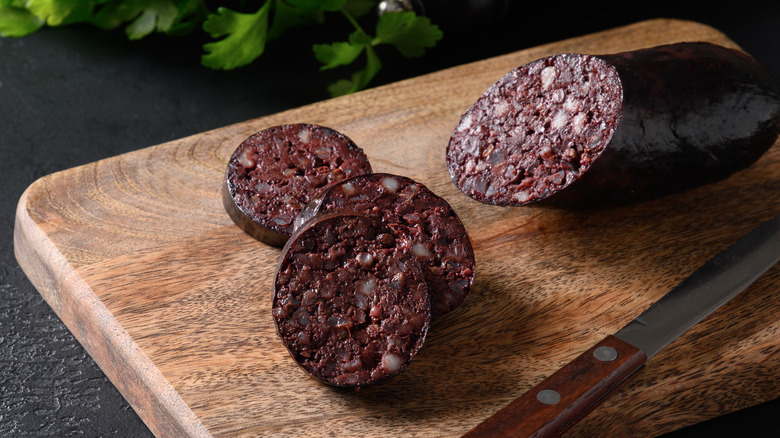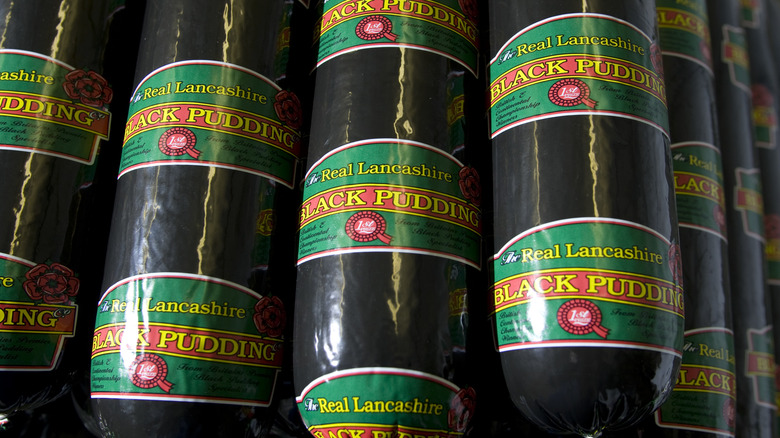What Is Blood Sausage, And Is It The Same As Black Pudding?
If you ever want to serve blood sausage at a dinner party, you might want to call it black pudding. Those in the know understand that the two are exactly the same thing, while those who don't (and are prone to faint at the sight of blood) might be a tad more willing to take a nibble.
Black pudding is merely the British name for blood sausage, though the French also call their version "boudin noir," which translates to black pudding. The reason it's referred to as a "pudding" by Brits remains a mystery. Nearly all desserts are called puddings in the U.K., as is the famous Yorkshire pudding (a bread-like popover), but black pudding is nothing like either. This darkly-colored type of sausage is also known as morcilla in Spain, drisheen in Ireland, and soondae in Korea.
While the ingredients in blood sausage depend on where it's made, Western versions nicknamed "black pudding" are usually made with onions, herbs, spices, animal fat, oatmeal or barley as a filler, and of course, pig's blood. It is typically a mild sausage, a little on the sweet side, and is served in various ways in the United Kingdom, most notably as part of a full English breakfast.
Why add blood to sausage?
Blood sausage is a prime example of nose-to-tail eating, or the concept of not wasting a bit (or a drop) of what an animal produces when it's slaughtered. Many overlooked cuts of meat called offal, which include organs and other underused parts, are a part of this cuisine. Even blood is repurposed in various ways by butchers and charcuterie experts around the world.
Many believe the earliest reference to blood sausage is found in Homer's "Odyssey," where the famed author writes, "Here at the fire are goats' paunches lying, which we set there for supper, when we had filled them with fat and blood." Ancient Spartans were also familiar with using blood in recipes, as seen in a dish called melas zomos or black broth, which was made with boiled pig's legs, blood, and vinegar.
Animal blood is also a remarkably good binder, which is likely what made it a desirable ingredient for sausage. As it cools, it congeals into a firm texture, and when combined with an additional filler such as grains, blood makes for a nice, bulky sausage that holds its shape.
Cooking with blood sausage
As far as eating and cooking with blood sausage, it helps to think of it as, well, sausage. Black pudding is cooked before you buy it, but it's best cooked again to heat it through and create a nice texture. In the aforementioned full English breakfasts (and Irish breakfasts, for that matter), thick slices of blood sausage are fried on both sides until crisp. You can also use it in sausage rolls, as the sausage mixture for Scotch eggs, or even use it in place of Canadian bacon in eggs Benedict.
Blood sausage can also be part of the filling for samosas or empanadas, and is popularly used to make a hash dish with potatoes, bell peppers, and onions, which you can serve with a fried egg on top for a protein boost. With smaller links of blood sausage, many people crisp them up in the oven or in a skillet and serve them with caramelized onions and mashed potatoes as a hearty dinner, or with eggs and toast for breakfast. Any way you cook it up, a good black pudding can be bloody delicious.



